As the Horsemen’s Tariff begins to get established, we must look at what it has so far achieved and knock down some of the misconceptions being portrayed by those who clearly want the tariff to fail.
The tariff became effective from February 7 for all jump races. An increasing number of owners and trainers are being supportive by choosing not to run their horses in races below tariff and this support is sending a strong message to racecourses. Gradually, the tariff is allowing us to refute the claim that, whatever the prize-money, ‘they’ll come’. It is important to re-emphasise the tariff is a guide that provides owners and trainers with minimum levels of prize-money for which we recommend they should be running. The tariff was never intended to coerce owners and trainers to boycott meetings.
We want the tariff to increase competition between courses, ensuring that those which meet the tariff have the expectation they will attract more runners and better quality fields. Already there are glowing examples of jump courses that are meeting the tariff for most of their races.
Top of the tree is Taunton which, up to March 3, will have put on 21 races, all them above tariff. Ffos Las, Fakenham, Ludlow and Musselburgh have also proved to be tariff-friendly racecourses in these early weeks and I therefore urge you to support races at these courses that are above the specified level.
There will always be occasions when even the most avid supporters of our concept feel it necessary to run their horses in races that do not comply with the tariff. When an owner and his trainer have been looking for a suitable race for a horse throughout the winter months, it is entirely understandable that they would not want to give up a running opportunity even if the prize-money is not compliant.
However, on those occasions where owners and trainers do have choices, I ask them to choose the race that complies with the tariff. This will help create the competitive tension that is so important to the process. Competition for runners between tracks is not only good for the horsemen; it is good for the whole industry and should be a cornerstone of racing’s restructuring plans.
The recent agreement with Jockey Club Racecourses, in which they have pledged to put an additional £2.2 million into prize-money in 2011, has done much to enhance their relationship with the Horsemen’s Group. It means more of the races run on their 14 courses will comply with the tariff as their own contribution to prize-money increases to £15.4m. Put into perspective, this increase means JCR now accounts for almost 50% of prize-money contributions made by all racecourses, yet are responsible for just 25% of the whole fixture list.
It is the ethos of JCR to support quality racing, yet it has been a convenient accusation made by some other racecourses that, through the tariff, the horsemen are encouraging racecourses to ‘dumb down’ their race programmes. This is not the case. The Horsemen’s Group recognises that quality racing provides the foundation of any racing industry. We would never set out to impair our international competitiveness.
Members should note that the ROA has played a very significant role in the whole tariff process in logging prize-money and tariff comparisons for each jumping fixture since the beginning of February.
We have also written to all ROA members asking them to support the tariff charter and, to date, have had approaching 2,000 indications of support from owners, trainers and jockeys against just a handful of ‘no votes’.
Our new ROA website has been invaluable in enabling us to set up an automatic voting system while listing every name of support on the website.
Yes, racing’s own example of ‘people power’ is gradually taking hold.



